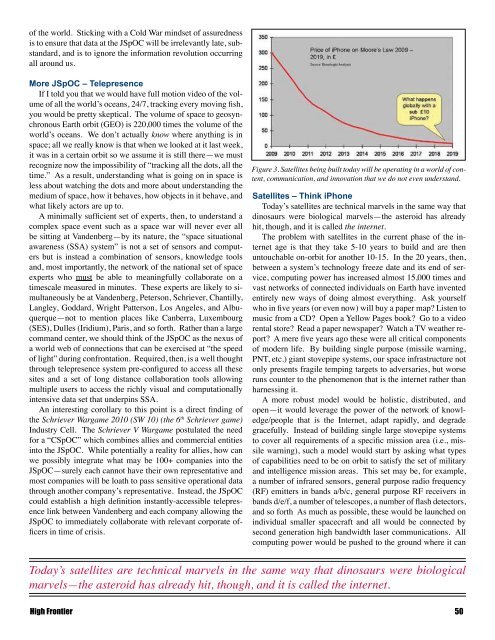Schriever Wargame 2010 - Air Force Space Command
Schriever Wargame 2010 - Air Force Space Command
Schriever Wargame 2010 - Air Force Space Command
You also want an ePaper? Increase the reach of your titles
YUMPU automatically turns print PDFs into web optimized ePapers that Google loves.
of the world. Sticking with a Cold War mindset of assuredness<br />
is to ensure that data at the JSpOC will be irrelevantly late, substandard,<br />
and is to ignore the information revolution occurring<br />
all around us.<br />
More JSpOC – Telepresence<br />
If I told you that we would have full motion video of the volume<br />
of all the world’s oceans, 24/7, tracking every moving fish,<br />
you would be pretty skeptical. The volume of space to geosynchronous<br />
Earth orbit (GEO) is 220,000 times the volume of the<br />
world’s oceans. We don’t actually know where anything is in<br />
space; all we really know is that when we looked at it last week,<br />
it was in a certain orbit so we assume it is still there—we must<br />
recognize now the impossibility of “tracking all the dots, all the<br />
time.” As a result, understanding what is going on in space is<br />
less about watching the dots and more about understanding the<br />
medium of space, how it behaves, how objects in it behave, and<br />
what likely actors are up to.<br />
A minimally sufficient set of experts, then, to understand a<br />
complex space event such as a space war will never ever all<br />
be sitting at Vandenberg—by its nature, the “space situational<br />
awareness (SSA) system” is not a set of sensors and computers<br />
but is instead a combination of sensors, knowledge tools<br />
and, most importantly, the network of the national set of space<br />
experts who must be able to meaningfully collaborate on a<br />
timescale measured in minutes. These experts are likely to simultaneously<br />
be at Vandenberg, Peterson, <strong>Schriever</strong>, Chantilly,<br />
Langley, Goddard, Wright Patterson, Los Angeles, and Albuquerque—not<br />
to mention places like Canberra, Luxembourg<br />
(SES), Dulles (Iridium), Paris, and so forth. Rather than a large<br />
command center, we should think of the JSpOC as the nexus of<br />
a world web of connections that can be exercised at “the speed<br />
of light” during confrontation. Required, then, is a well thought<br />
through telepresence system pre-configured to access all these<br />
sites and a set of long distance collaboration tools allowing<br />
multiple users to access the richly visual and computationally<br />
intensive data set that underpins SSA.<br />
An interesting corollary to this point is a direct finding of<br />
the <strong>Schriever</strong> <strong>Wargame</strong> <strong>2010</strong> (SW 10) (the 6 th <strong>Schriever</strong> game)<br />
Industry Cell. The <strong>Schriever</strong> V <strong>Wargame</strong> postulated the need<br />
for a “CSpOC” which combines allies and commercial entities<br />
into the JSpOC. While potentially a reality for allies, how can<br />
we possibly integrate what may be 100+ companies into the<br />
JSpOC—surely each cannot have their own representative and<br />
most companies will be loath to pass sensitive operational data<br />
through another company’s representative. Instead, the JSpOC<br />
could establish a high definition instantly-accessible telepresence<br />
link between Vandenberg and each company allowing the<br />
JSpOC to immediately collaborate with relevant corporate officers<br />
in time of crisis.<br />
Figure 3. Satellites being built today will be operating in a world of content,<br />
communication, and innovation that we do not even understand.<br />
Satellites – Think iPhone<br />
Today’s satellites are technical marvels in the same way that<br />
dinosaurs were biological marvels—the asteroid has already<br />
hit, though, and it is called the internet.<br />
The problem with satellites in the current phase of the internet<br />
age is that they take 5-10 years to build and are then<br />
untouchable on-orbit for another 10-15. In the 20 years, then,<br />
between a system’s technology freeze date and its end of service,<br />
computing power has increased almost 15,000 times and<br />
vast networks of connected individuals on Earth have invented<br />
entirely new ways of doing almost everything. Ask yourself<br />
who in five years (or even now) will buy a paper map? Listen to<br />
music from a CD? Open a Yellow Pages book? Go to a video<br />
rental store? Read a paper newspaper? Watch a TV weather report?<br />
A mere five years ago these were all critical components<br />
of modern life. By building single purpose (missile warning,<br />
PNT, etc.) giant stovepipe systems, our space infrastructure not<br />
only presents fragile temping targets to adversaries, but worse<br />
runs counter to the phenomenon that is the internet rather than<br />
harnessing it.<br />
A more robust model would be holistic, distributed, and<br />
open—it would leverage the power of the network of knowledge/people<br />
that is the Internet, adapt rapidly, and degrade<br />
gracefully. Instead of building single large stovepipe systems<br />
to cover all requirements of a specific mission area (i.e., missile<br />
warning), such a model would start by asking what types<br />
of capabilities need to be on orbit to satisfy the set of military<br />
and intelligence mission areas. This set may be, for example,<br />
a number of infrared sensors, general purpose radio frequency<br />
(RF) emitters in bands a/b/c, general purpose RF receivers in<br />
bands d/e/f, a number of telescopes, a number of flash detectors,<br />
and so forth As much as possible, these would be launched on<br />
individual smaller spacecraft and all would be connected by<br />
second generation high bandwidth laser communications. All<br />
computing power would be pushed to the ground where it can<br />
Today’s satellites are technical marvels in the same way that dinosaurs were biological<br />
marvels—the asteroid has already hit, though, and it is called the internet.<br />
High Frontier 50

















